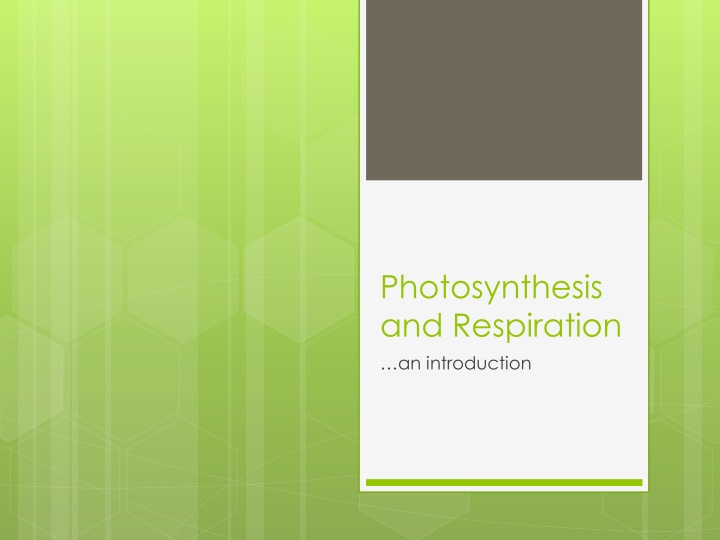
Basics of Photosynthesis and Respiration
Delve into the fundamental concepts of photosynthesis, exploring the major players, processes, and significance of this vital biological mechanism. From the key reactions to the necessary components, this introduction sheds light on the 'what,' 'when,' 'where,' 'why,' and 'how' of photosynthesis.
Download Presentation

Please find below an Image/Link to download the presentation.
The content on the website is provided AS IS for your information and personal use only. It may not be sold, licensed, or shared on other websites without obtaining consent from the author. If you encounter any issues during the download, it is possible that the publisher has removed the file from their server.
You are allowed to download the files provided on this website for personal or commercial use, subject to the condition that they are used lawfully. All files are the property of their respective owners.
The content on the website is provided AS IS for your information and personal use only. It may not be sold, licensed, or shared on other websites without obtaining consent from the author.
E N D
Presentation Transcript
Photosynthesis and Respiration an introduction
Lets start with Photosynthesis
The 5 Ws of Photosynthesis Who? The major players are: Carbon dioxide, water, glucose, oxygen, sunlight, and ATP
The 5 Ws of Photosynthesis What? Photosynthesis = you tell me! 2 types of reactions: Light-dependent = converting sunlight energy to chemical energy (ATP) Light-independent = uses chemical energy to produce simple sugars
The big equation light 6 CO2+ 6 H2O C6H12O6+ 6 O2
The 5 Ws of Photosynthesis When? Light-dependent Light-independent
The 5 Ws of Photosynthesis Where? Plant cells! Key words: chloroplast, chlorophyll (pigment), thylakoid membrane, photosystems
The 5 Ws of Photosynthesis Why? Let s review the 5 requirements for living things: Orderly structure Reproduce Adapt to their environment *Grow and develop* *Require energy* 1. 2. 3. 4. 5.
The 5 Ws of Photosynthesis How? Light-dependent reactions: Light = energy Excites electrons in chlorophyll Move down electron transport chain (proteins) in thylakoid membrane Each stair step down chain releases energy to: Break H2O to release oxygen and new electrons, Pump H+ in to create NADPH, and Bind P to ADP, forming ATP Photolysis
Light- Dependent Reactions Figure 9.5 (Sect 9.2)
The 5 Ws of Photosynthesis How? cont d Light-independent reactions: Calvin Cycle in stroma of chloroplast CO2 in & 6-carbon sugars (glucose) out ANd9GcS_8T7WjjwWOcs2zOBW7OsJ2tJa3SaRohCRaMnbG8tR1KCZKpml-IljYN4c
And now Respiration
The 5 Ws of Respiration Who? The major players are: Carbon dioxide, water, glucose, oxygen, and ATP Does this look familiar?
The Respiration Equation C6H12O6 + 6O2 6CO2 + 6H2O + Energy
The 5 Ws of Respiration What? Cellular respiration = the break down of food molecules to produce ATP 3 stages: Glycolysis = breaks down glucose to pyruvic acid Citric acid cycle (aka Krebs cycle) = similar to the Calvin cycle; produces CO2 and ATP 3. Electron transport chain = energy released in steps to produce ATP and H2O 1. 2.
The 5 Ws of Respiration When? Glycolysis = anaerobic (anytime) Citric acid cycle and electron transport chain = aerobic (needs __________) oxygen
The 5 Ws of Respiration Where? In all living cells! Glycolysis: in cytoplasm Citric acid cycle: in mitochondria Electron transport chain: in inner membrane of mitochondria Where are these places?
A quick tour of the cell Let s zoom in a little further
The Mitochondria aka the Power house of the cell Does this structure remind you of anything we talked about earlier? The Chloroplast!
The 5 Ws of Respiration Why? 2nd step in releasing energy for the organism Remember the requirements of life!
The 5 Ws of Respiration How? 3 stages: Glycolysis = breaks down glucose to pyruvic acid *Fermentation Citric acid cycle (aka Krebs cycle) = similar to the Calvin cycle; produces CO2 and ATP Electron transport chain = energy released in steps to produce ATP and H2O 1. 2. 3.
Electron transport chain FYI Figure 9.11
The 5 Ws of Respiration How? Cont d Fermentation = occurs, for example, during heavy exercise when cells are lacking oxygen Oxygen is the final electron acceptor in the electron transport chain. Without it, energy (ATP) cannot be produced Definition: Anaerobic means of creating ATP (supplies energy when oxygen is scarce) 2 types: 1. Lactic acid 2. Alcoholic
Lactic acid fermentation Forms lactic acid in muscles Alcoholic fermentation Used by yeast cells and bacteria to produce CO2 and alcohol (i.e. bread)
Lets make some comparisons: Figure 9.12
Review Table 9.1
Video time! The Light Reactions Bill Nye Plant Pigments Cowboy Respiration
